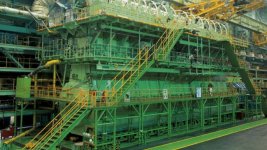GregP27
Bronze Member
Let's look at that claim.
1) GM makes a 2.0 L diesel rated at 151 HP @ 4,000 rpm. That means 198 ft-lbs of torque. It can rev as high as 4,000 rpm.
2) Kioti makes a 1.8+L diesel rated at 45 HP @ 2,000 rpm. That means 118 ft-lbs of torque. Rated rpm is 2,600.
So, the Kioti makes about 60% of the torque of the automotive diesel at 2,000 rpm and lasts for an estimated 20,000 hours before major wearout. The GM car won't last anywhere NEAR that long in hours, and is used completely differently for a purpose not exactly connected with compact utility tractor use.
It's an apples to oranges comparison. Interesting, but unrelated, except by being diesels.
If you out the GM diesel into a Kioti tractor, it would wear out VERY quickly because it is NOT constructed for commercial industrial use.
1) GM makes a 2.0 L diesel rated at 151 HP @ 4,000 rpm. That means 198 ft-lbs of torque. It can rev as high as 4,000 rpm.
2) Kioti makes a 1.8+L diesel rated at 45 HP @ 2,000 rpm. That means 118 ft-lbs of torque. Rated rpm is 2,600.
So, the Kioti makes about 60% of the torque of the automotive diesel at 2,000 rpm and lasts for an estimated 20,000 hours before major wearout. The GM car won't last anywhere NEAR that long in hours, and is used completely differently for a purpose not exactly connected with compact utility tractor use.
It's an apples to oranges comparison. Interesting, but unrelated, except by being diesels.
If you out the GM diesel into a Kioti tractor, it would wear out VERY quickly because it is NOT constructed for commercial industrial use.

